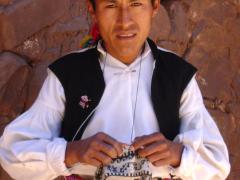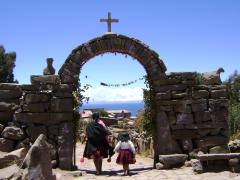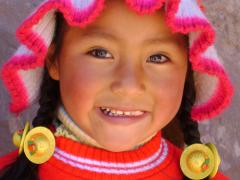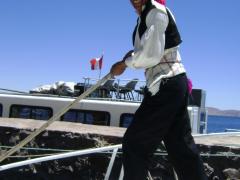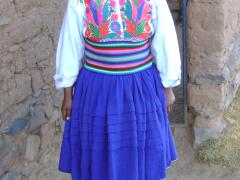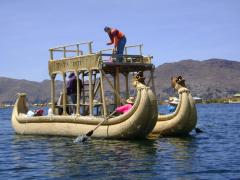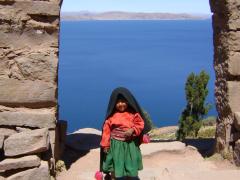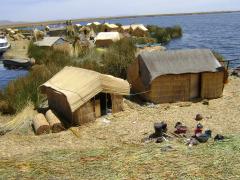The Islands of Lake Titicaca
Lake Titicaca is a massive lake, the highest navigable lake in the world at an elevation of 3,812 meters (12,507 feet). Both Peru and Bolivia share this deep blueish-green lake with several islands on the Peru side and several on the Bolivia side which are inhabited by indigenous people who mostly speak Quechua and Aymara, two languages that date from the Inca empire. A visit to the islands is an important part of visiting this natural wonder of the world.
We took a two day boat trip to three islands on the Peruvian side of Lake Titicaca: Uros, Amantaní and Taquile. We first visited the Uros Islands, which in reality are dozens of floating artificial islands. Each island is made of reeds which are bound together and maintained by the inhabitants. People actually live on these small floating islands in reed houses. Not only are the houses and the islands themselves made of reeds but they make boats out of them too. Is is fascinating to see all the different designs of boats made solely of reeds. The people of the islands used to make a living from fishing, but this has replaced by tourism on most of the islands. The women wear incredibly bright neon-colored clothes which glow against the yellow reeds and blue lake and pastel-colored sky.
The second island we visited was Amantaní. The people make a living hosting visitors which provides an opportunity to experience this remote Quechua culture. There are two pre-Inca ruins on this island in which we visited one on top of the hill called Pachamama (Mother Earth). All along the amazing worked-stone trails people of the island lined the path selling their handicrafts of knitted Peruvian hats, scarfs, woven clothes and hand made bags. Young children followed us playing the tube flute in hopes of getting a little tip. I tipped them a pencil each to leave us alone. It was rather bothersome after awhile. Randy even had a dream that night -- on the way to the outhouse in the middle of the night a vendor was out there selling some kind of handicraft.
There are no hotels, cars, horses, cows, or dogs. The people who live on Amantani live a simple life. They haul all the goods on their back, up and own the steep inclines. All spare land is terraced and they grow potatoes, wheat and vegetables. We watched a small group of people planting potatoes. Instead of plowing with machinery or oxen, I watched two men acting as oxen pulling a wooden plow through the brown earth, followed by a women directing the blade through the freshly prepared soil. Three other women sat to the side sorting the starter tubers and chatting in Quechua. One had a beautiful book of the history of the island which she would happily sell to us for $10.
The island has a generator for electricity but is used only for short time during the early evening. Other people use solar panels to generate electricity, which with increased energy prices is quickly becoming a top choice. One of the children of our host family did homework under the single light for less then an hour. We ate by candle light and shared this meal with one other couple from Germany who enjoyed the experience of getting away from it all. All the three meals we ate were vegetarian and very simple: soup, rice and steamed vegetables, bread, cheese and tea. We stayed upstairs in a two story adobe house which was built right at the edge of the lake. During the evening I sat out on the balcony watched the lake, the stars, the moon and the sleeping sheep. I had never seen the stars and the moon shine so brightly. I felt at peace and went bed at 9:00.
The third island, Taquile, again required a huge climb up to the village. What I liked about this island was the traditional dress worn by the men, beautiful colors which complimented their bronze skin and handsome physique. The men on this island knit and the women weave, both of which are intricate and colorful. In 2005, "Taquile and Its Textile Art" were honored by being proclaimed "Masterpieces of the Oral and Intangible Heritage of Humanity" by UNESCO.
The people of Taquile seem to live a together as a tight knit community. Taquileños run their society based on community collectivism and on the Inca moral code "ama sua, ama llulla, ama qhilla" (Quechua: do not steal, do not lie, do not be lazy). It seems to work as far as I can see they live in peace, without yelling, hitting, drunkeness and time to think and look out on to the lake. They have enough food to eat and water to drink and all seem to be educated Not too bad of a life, living on a remote island in Peru.

